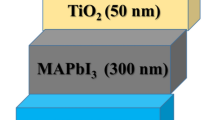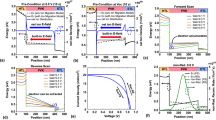Abstract
The progress of perovskite solar cell (PSC) technology is held back due to the presence of anomalous hysteresis in its current–voltage (J–V) characteristics. Understanding the physical origin of J–V hysteresis is crucial for the development of hysteresis-free solar cell. We computationally explore the relative contribution of dominant physical phenomenon that could cause hysteresis in PSC. We explore that accumulation of mobile ions at the interfaces of the cell inside perovskite produces a space charge which in combination with charge trapping/detrapping in deep traps results in hysteresis which is often characterized by an S shaped behavior of J–V curve. We further explore that shallow traps at the interfaces of carrier-extraction layers alone exhibit the combined effects of ion accumulation and deep charge traps, and lead to J–V hysteresis in PSCs. Moreover, we investigate the effect of energy level of deep/shallow traps and show that the energy level of deep/shallow traps plays an important role in J–V characteristics of the cell. Lastly, we explore that high minority carrier lifetime in the bulk of the perovskite mitigates the effects of ion accumulation and/or charge trapping/detrapping and leads to hysteresis-free cell. The results presented in this work are beneficial for the development of hysteresis-free PSCs.










Similar content being viewed by others
References
L.C. Andreani, A. Bozzola, P. Kowalczewski, M. Liscidini, L. Redorici, Silicon solar cells: toward the efficiency limits. Adv. Phys. 4(1), 1548305 (2019)
R. Asadpour, R.V. Chavali, M. Ryyan Khan, M.A. Alam, Bifacial si heterojunction-perovskite organic-inorganic tandem to produce highly efficient (η t* 33%) solar cell. Appl. Phys. Lett. 106(24), 243902 (2015)
B. Chen, M. Yang, S. Priya, K. Zhu, Origin of j-v hysteresis in perovskite solar cells. J. Phys. Chem. Lett. 7(5), 905–917 (2016)
B. Chen, P.N. Rudd, S. Yang, Y. Yuan, J. Huang, Imperfections and their passivation in halide perovskite solar cells. Chem. Soc. Rev. 48(14), 3842–3867 (2019)
J.M. Frost, K.T. Butler, A. Walsh, Molecular ferroelectric contributions to anomalous hysteresis in hybrid perovskite solar cells. Appl. Mater. 2(8), 081506 (2014)
H. Imran, N.Z. Butt, Computational study of hybrid nanomaterial/insulator/silicon solar cells. IEEE Trans. Electron Dev. 62(10), 3111–3116 (2015)
H. Imran, N.Z. Butt, Investigation of dominant hysteresis phenomenon in perovskite solar cell. in 2016 IEEE 43rd Photovoltaic Specialists Conference (PVSC), IEEE, pp. 0776–0780 (2016)
H. Imran, I. Durrani, M. Kamran, T.M. Abdolkader, M. Faryad, N.Z. Butt, High-performance bifacial perovskite/silicon double-tandem solar cell. IEEE J. Photovolt. 8(5), 1222–1229 (2018)
S. Iqbal, K. Riaz, H. Imran, Y.H. Khattak, F. Baig, Z. Ahmad, Computational modelling of monolithically stacked perovskite/silicon tandem solar cells using monofacial and bifacial designs. Optik 206, 163427 (2020)
H.S. Kim, N.G. Park, Parameters affecting i–v hysteresis of ch3nh3pbi3 perovskite solar cells: effects of perovskite crystal size and mesoporous tio2 layer. J. Phys. Chem. Lett. 5(17), 2927–2934 (2014)
J. Lehr, M. Langenhorst, R. Schmager, F. Gota, S. Kirner, U. Lemmer, B.S. Richards, C. Case, U.W. Paetzold, Energy yield of bifacial textured perovskite/silicon tandem photovoltaic modules. Solar Energy Mater. Solar Cells 208, 110367 (2020)
C. Li, S. Tscheuschner, F. Paulus, P.E. Hopkinson, J. Kießling, A. Köhler, Y. Vaynzof, S. Huettner, Iodine migration and its effect on hysteresis in perovskite solar cells. Adv. Mater. 28(12), 2446–2454 (2016)
W. Nie, H. Tsai, R. Asadpour, J.C. Blancon, A.J. Neukirch, G. Gupta, J.J. Crochet, M. Chhowalla, S. Tretiak, M.A. Alam et al., High-efficiency solution-processed perovskite solar cells with millimeter-scale grains. Science 347(6221), 522–525 (2015)
N. NREL, Best research-cell efficiencies (2019)
R.F. Pierret, Semiconductor device fundamentals testbook module a: semiconductor basics (2013)
U.B. Qasim, H. Imran, M. Kamran, M. Faryad, N.Z. Butt, Computational study of stack/terminal topologies for perovskite based bifacial tandem solar cells. Solar Energy 203, 1–9 (2020)
Yh Shao, Z. Xiao, C. Bi, Y. Yuan, J. Huang, Origin and elimination of photocurrent hysteresis by fullerene passivation in CH 3 NH 3 PBI 3 planar heterojunction solar cells. Nat. Commun. 5(1), 1–7 (2014)
H.J. Snaith, A. Abate, J.M. Ball, G.E. Eperon, T. Leijtens, N.K. Noel, S.D. Stranks, J.T.W. Wang, K. Wojciechowski, W. Zhang, Anomalous hysteresis in perovskite solar cells. J. Phys. Chem. Lett. 5(9), 1511–1515 (2014)
P. Tockhorn, P. Wagner, L. Kegelmann, J.C. Stang, M. Mews, S. Albrecht, L. Korte, Three-terminal perovskite/silicon tandem solar cells with top and interdigitated rear contacts. ACS Appl. Energy Mater. 3(2), 1381–1392 (2020)
W. Tress, N. Marinova, T. Moehl, S.M. Zakeeruddin, M.K. Nazeeruddin, M. Grätzel, Understanding the rate-dependent J-V hysteresis, slow time component, and aging in CH 3 NH 3 PBI 3 perovskite solar cells: the role of a compensated electric field. Energy Environ. Sci. 8(3), 995–1004 (2015)
S. van Reenen, M. Kemerink, H.J. Snaith, Modeling anomalous hysteresis in perovskite solar cells. J. Phys. Chem. Lett. 6(19), 3808–3814 (2015)
R. Varache, C. Leendertz, M. Gueunier-Farret, J. Haschke, D. Muñoz, L. Korte, Investigation of selective junctions using a newly developed tunnel current model for solar cell applications. Solar Energy Mater. Solar Cells 141, 14–23 (2015)
J. Wei, Y. Zhao, H. Li, G. Li, J. Pan, D. Xu, Q. Zhao, D. Yu, Hysteresis analysis based on the ferroelectric effect in hybrid perovskite solar cells. J. Phys. Chem. Lett. 5(21), 3937–3945 (2014)
G. Xing, N. Mathews, S.S. Lim, N. Yantara, X. Liu, D. Sabba, M. Grätzel, S. Mhaisalkar, T.C. Sum, Low-temperature solution-processed wavelength-tunable perovskites for lasing. Nat. Mater. 13(5), 476–480 (2014)
G. Xing, B. Wu, S. Chen, J. Chua, N. Yantara, S. Mhaisalkar, N. Mathews, T.C. Sum, Interfacial electron transfer barrier at compact tio2/ch3nh3pbi3 heterojunction. Small 11(29), 3606–3613 (2015)
K. Yamamoto, K. Yoshikawa, H. Uzu, D. Adachi, High-efficiency heterojunction crystalline SI solar cells. Jpn. J. Appl. Phys. 5S7(83), 08RB20 (2018)
F. Yang, W. Zuo, H. Liu, J. Song, H. Liu, J. Li, S.M. Jain, Ion-migration and carrier-recombination inhibition by the cation-$\pi $ interaction in planar perovskite solar cells. Org. Electron. 75, 105387 (2019)
Acknowledgements
The authors would like to acknowledge Hayat Ullah and Saqib Iqbal for their fruitful discussions and valuable comments to improve the quality of the paper.
Author information
Authors and Affiliations
Corresponding author
Additional information
Publisher’s Note
Springer Nature remains neutral with regard to jurisdictional claims in published maps and institutional affiliations.
Appendix
Appendix
The refractive index (n) and extinction coefficient (k) of perovskite used in this work as a function of wavelength (\(\lambda \)) is shown in Fig. 11.
The refractive index (n) and extinction coefficient (k) of perovskite used in this work as a function of wavelength (\(\lambda \)) [24]
Rights and permissions
About this article
Cite this article
Qasim, U.B., Qasim, H.B., Saeed, M.M. et al. Investigating physical origin of dominant hysteresis phenomenon in perovskite solar cell. J Mater Sci: Mater Electron 32, 5274–5285 (2021). https://doi.org/10.1007/s10854-021-05258-1
Received:
Accepted:
Published:
Issue Date:
DOI: https://doi.org/10.1007/s10854-021-05258-1





